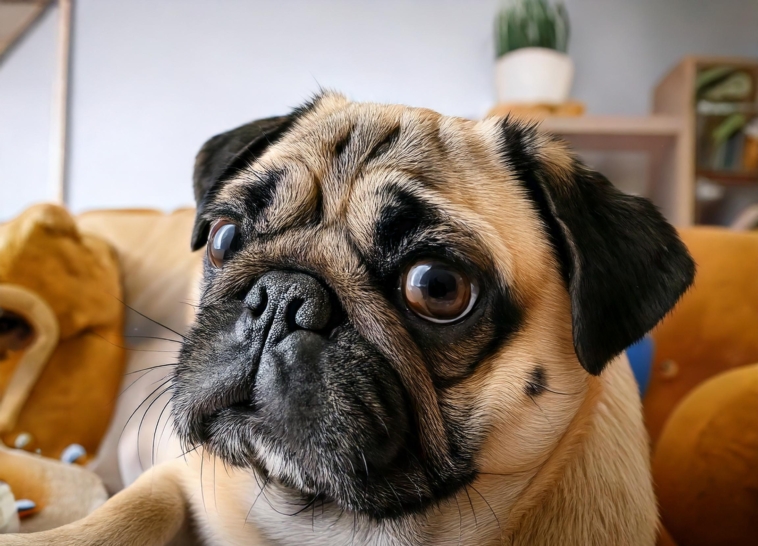Introduction: Typical Health Issues in Pugs (A.K.A “The Adorable Drama Queens of the Dog World”)
Let’s be real—pugs didn’t exactly win the genetic lottery when it comes to health. With faces only a mother (or a pug enthusiast) could love, these little snort-machines are essentially waddling vet visits. But hey, we adore them for it! Being a pug parent is about being on your toes because their list of health problems is longer than their noses… oh wait, they don’t have those.
Top Pug Problems (Also Known As: “Why My Vet Has Me on Speed Dial”)
- Brachycephalic Syndrome: Translation? “I’m having trouble breathing but I’m adorable while doing it.” Their compressed snouts mean breathing is a luxury.
- Skin Issues: Pug wrinkles = prime real estate for bacteria. Consider them to be small croissant dogs that require constant wipe-downs.
- Obesity: These fellas are snacking aficionados more than your uncle at Thanksgiving. Without moderation, they blow up like a loaf of bread.
- Eye Issues: With those giant googly eyes, it’s no wonder they encounter more drama than a reality TV show contestant.
- Hip Dysplasia: Their hips don’t lie—and sometimes they creak and wobble too.
Brachycephalic Syndrome: Snorting is Their Second Language
- Here’s the greatest hits compilation of the pug’s breathing ailments:
- Stenotic Nares: Their nasal are more tapered post holiday bender.
- Elongated Soft Palate: Picture having a curtain in your throat—it flails where it shouldn’t.
- Everted Laryngeal Saccules: Fancy terms for “additional throat flab leading to traffic jams.”
Symptoms include:
- Creepy wheezing sounds (you’ll think your pug sounds like a miniature, broken Darth Vader)
- Exercise intolerance (AKA “I walked for 2 minutes, now I need to take a nap for 2 hours”)
- Blue-ish gums (where style collides with oxygen deficit)
- Melting due to heat during the summer like a furry popsicle
Skin Issues: Wrinkles Gone Wild
Wrinkles are adorable until they’re. bacterial breeding grounds. Here’s what happens:
- Atopic Dermatitis: Essentially pug eczema. Bring on the scratching orchestra.
- Pyoderma: Bacterial rave in the fold-y skin.
- Mange: In case your pug is transforming into a hairless mole rat, mites could be the culprit.
- Yeast Infections: Stomps along, walks in, talks funky. Typical triple threat.
- Food Allergies: They’ll inform you through itching, gassiness, or the unexplained puddle on the carpet.
- Pug Owner Tip: Bathe them like royalty—pH-balanced shampoo, wash those folds, and coddle them like the wrinkle divas they are.
Eye Problems: The “I See You… Maybe” Saga
Pugs’ eyes are so large, they’re almost a zip code unto themselves. But said larger-than-life orbs come with issues:
- Proptosis: “I love you” eyes that almost pop on out. Yeah, it’s as frightening as it sounds.
- Dry Eye: Blink, blink, blink—and still dry. They require lube drops more than a 90s boy band requires gel.
- Entropion: When eyelashes turn renegade and poke their own eyeballs. Not cool.
- Pigmentary Keratitis: Brown spots obstructing vision—essentially a pug’s equivalent of smoky glasses.
Cure? Visits to the vet, eye drops, and realizing that those bug-eyes need as much upkeep as a classic automobile.
Joint & Bone Drama: Waddle, Don’t Wiggle Too Hard
Since pugs are small, potato-shaped animals, their joints bear a huge amount of weight.
- Hip Dysplasia: Their hips are just not cool. They click, wobble, and on occasion tell “nope” to walks.
- Patellar Luxation: Kneecaps playing hide-and-seek. (Spoiler alert: it hurts.)
- Spinal Issues: Pugs have corkscrew backs because apparently, evolution had something to prove.
Teeth Troubles: Chompers Need Love Too
Their teeth are important, unless you enjoy the aroma of swamp breath.
- Book annual professional cleanings.
- Add some dental chews (doggie breath mints, essentially).
- Take a peek in their mouth every now and then if it smells like death, call the vet.
Preventative Pug Care (A.K.A Keeping the Drama to a Minimum)
- Vet Visits: Don’t ghost your vet. Regular checkups = less pug drama.
- Weight Watching: No chubby pug-tatoes allowed. Keep snacks in check.
- Ear Cleaning: Gunk = gross. Clean ’em out weekly.
- Skin & Eye TLC: Moisturize those folds and keep an eye (literally) on their peepers.
- Hydration: Always have fresh water—pugs overheat faster than your phone in the sun.
Vet Check-Ups: The Real MVPs
- Your vet = your pug’s life coach. They’ll:
- Run blood tests (to make sure the inside’s doing okay).
- Keep weight on track (no judgment, just support).
- Spot eye/ear issues before they become full-blown soap operas.
- Manage vaccines and parasite treatments so your pug doesn’t become a flea hotel.
Final Thoughts (Or: How to Keep Your Pug from Falling Apart Like a Discount Robot)
- Feed ’em right. They’re not garbage disposals (even if they behave like one).
- Get the vet checked before things turn dramatic.
- Pay attention to their breathing—snorts are adorable, gasping is not.
- Love their wrinkles but wash them like you mean it.
Pug parenting is like having a car that’s always producing a new noise—but with so many more snuggles.
Bonus Pug Parent Testimonials
“Fido transformed from couch potato to king of zoomies after we changed his kibble and regularly cleaned his nose folds.” Jenny, professional pug cuddler
“Rocky would steal my dinner. Now, with proper portions and daily walks, he ignores my pizza and runs around in circles instead.” Karen, proud pug weight-loss coach





